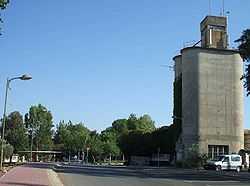Mahanayim
| Mahanayim | |
|---|---|
 | |
 Mahanayim | |
| Coordinates: 32°59′21.48″N 35°34′13.08″E / 32.9893000°N 35.5703000°ECoordinates: 32°59′21.48″N 35°34′13.08″E / 32.9893000°N 35.5703000°E | |
| Council | Upper Galilee |
| Region | Galilee |
| Affiliation | Kibbutz Movement |
| Founded |
1898 (first establishment) 1916 (first re-establishment) 1939 (second re-establishment) |
| Founded by |
Galician immigrants (1898) Poale Zion members (1916) Yodfat members (1939) |
| Website | http://kibbutzmahanayim.blogspot.com |
Mahanayim (Hebrew: מחניים, מַחֲנַיִם) is a kibbutz in northern Israel. Located around three kilometres northeast of Rosh Pina, it falls under the jurisdiction of Upper Galilee Regional Council. In 2006 it had a population of 346.
History
The land on which Mahanayim stands was purchased in 1892 by the Ahavat Zion (Love of Zion) Hovevei Zion organisation with the aim of establishing a moshava in the area. In 1898 a number of families from Galicia settled in the area, naming it Mahanayim after the Biblical city in Gilead, where Jacob stayed before he met again with his brother Esau and saw angels, therefore calling it Mahanayim (camps) of God (Genesis 32,2). However, it was not a success, largely due to the settlers' lack of familiarity with the region, a shortage of money, and a lack of professionalism, resulting in the community disintegrating. The Jewish Colonization Association ran a trial of growing tobacco in the area, but it too was a failure, and the village was abandoned in 1912.
In 1916 a kvutza of Poale Zion members arrived in the area, establishing the first working settlement in the Upper Galilee. In 1922 it became a moshav, but was abandoned in 1928.
The village was established for a third time in 1939 by members of kibbutz "Yodfat" from Safed.
Ben Ya'akov Airport is located to the south of the kibbutz.
Kibbutz Mahanaim operates a guesthouse that offers holistic and alternative medicine treatments. A sculpture studio and stained glass workshop on the grounds of the kibbutz are open to guests.[1]
In 2013, a member of Mahanaim, Penny Ur, was awarded an OBE from the Queen of England for her contribution to English language teaching.[2]
References
| ||||||